- Low-impact cardio refers to exercises that are gentle on the joints, such as walking, swimming, and cycling.
- These exercises improve oxygen exchange efficiency, gradually increasing lung capacity over time.
- Regular practice strengthens respiratory muscles, enhancing endurance and overall lung performance.
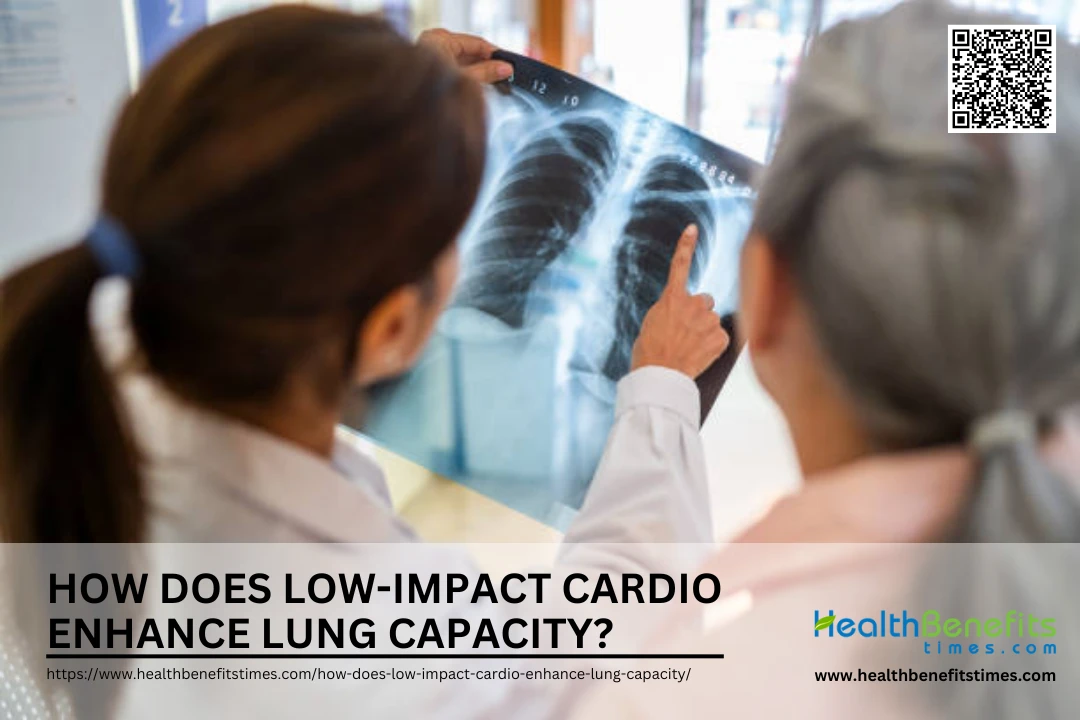 Low-impact cardio refers to exercises that minimize stress on the joints while engaging the cardiovascular system, such as walking, swimming, or cycling 1. Lung capacity is a critical measure of respiratory health, affecting endurance, oxygen delivery, and overall well-being. Engaging in low-impact cardio has been shown to significantly enhance lung capacity by improving respiratory muscle strength, oxygen exchange efficiency, and alveolar function. For instance, water aerobics improve chest mobility and pulmonary function in patients recovering from chronic illnesses 2. Yoga, another form of low-impact cardio, promotes lung expansion through deep breathing techniques, leading to improved forced vital capacity (FVC) and vital capacity (VC) 3. Research also highlights the potential of Tai Chi and similar activities to enhance pulmonary function through slow, controlled movements and rhythmic breathing 4.
Low-impact cardio refers to exercises that minimize stress on the joints while engaging the cardiovascular system, such as walking, swimming, or cycling 1. Lung capacity is a critical measure of respiratory health, affecting endurance, oxygen delivery, and overall well-being. Engaging in low-impact cardio has been shown to significantly enhance lung capacity by improving respiratory muscle strength, oxygen exchange efficiency, and alveolar function. For instance, water aerobics improve chest mobility and pulmonary function in patients recovering from chronic illnesses 2. Yoga, another form of low-impact cardio, promotes lung expansion through deep breathing techniques, leading to improved forced vital capacity (FVC) and vital capacity (VC) 3. Research also highlights the potential of Tai Chi and similar activities to enhance pulmonary function through slow, controlled movements and rhythmic breathing 4.
Low-impact cardio is especially beneficial for individuals with conditions such as COPD, where it aids in improving pulmonary efficiency without exacerbating symptoms 5. Regular participation in activities such as brisk walking or elliptical training also fosters improved VO2 max, a key indicator of lung health 6. Furthermore, incorporating Pilates into low-impact routines has been linked to increased lung capacity and diaphragmatic control 7.
Understanding Lung Capacity
Lung capacity refers to the total volume of air that the lungs can hold, a critical measure of respiratory health and overall physical fitness. It is influenced by several factors, including age, gender, lifestyle habits, and environmental conditions. Assessing lung capacity provides valuable insights into an individual’s respiratory efficiency and overall health. Regular testing can help monitor respiratory performance and detect early signs of respiratory illnesses. According to a study published in the American Journal of Respiratory and Critical Care Medicine, lung capacity declines gradually with age, starting as early as the mid-20s (8). Ensuring a healthy lifestyle and early intervention can play a pivotal role in maintaining optimal lung function.
Several intrinsic and extrinsic factors influence lung capacity. Genetics play a role, with some individuals naturally having larger lung volumes. Additionally, age and gender are significant determinants, as men typically have higher lung capacities than women of the same age and build (9). Smoking is a well-documented external factor that severely compromises lung health, reducing lung capacity by causing chronic inflammation and scarring of lung tissues (10). Similarly, prolonged exposure to air pollution and occupational hazards, such as dust or chemicals, can impair lung function over time (11). Physical fitness is another critical factor, as aerobic exercises like running and swimming can enhance lung capacity (12). On the contrary, obesity and a sedentary lifestyle are associated with decreased lung volumes (13).
Recognizing the signs of poor lung capacity is essential for early diagnosis and treatment. Common symptoms include shortness of breath, persistent coughing, and a decreased ability to perform physical activities (14). Frequent respiratory infections may also indicate compromised lung function (15). In severe cases, individuals may experience chest tightness or wheezing, which could signify chronic obstructive pulmonary disease (COPD) or asthma (16). Fatigue and low energy levels can also result from insufficient oxygen exchange due to diminished lung function. Early intervention, such as pulmonary rehabilitation and lifestyle modifications, can significantly improve symptoms and enhance quality of life.
How Low-Impact Cardio Enhances Lung Capacity?
Low-impact cardio exercises, such as walking and swimming, improve lung capacity by strengthening respiratory muscles, enhancing oxygen exchange, and promoting better overall respiratory function for long-term health.
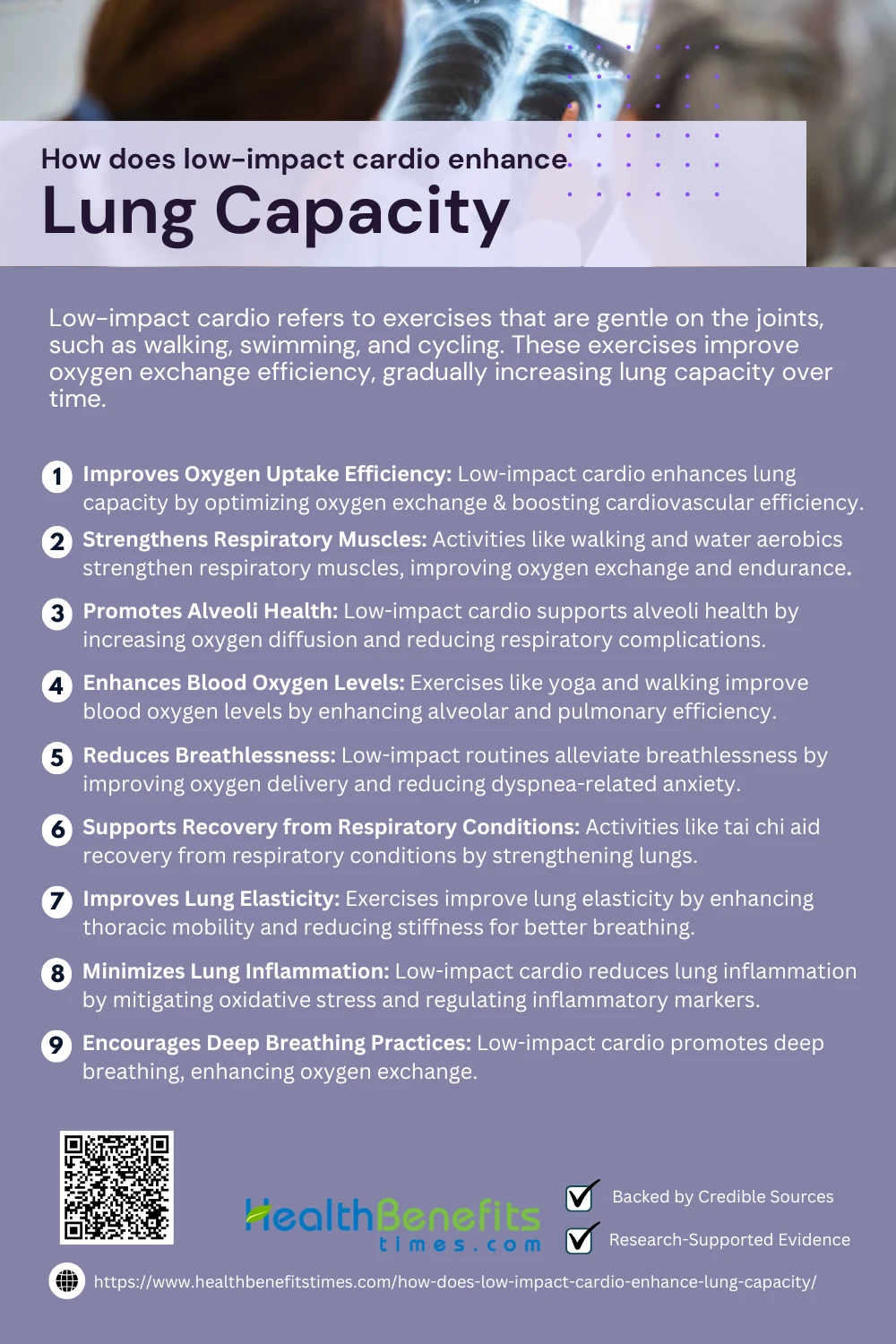 1. Improves Oxygen Uptake Efficiency
1. Improves Oxygen Uptake Efficiency
Low-impact cardio exercises, such as walking and swimming, significantly improve oxygen uptake efficiency by enhancing the lungs’ ability to transfer oxygen to the bloodstream. This process strengthens respiratory function and boosts endurance over time. Studies show that regular aerobic activity optimizes the oxygen exchange mechanism (9), enhances blood circulation (12), and promotes healthy lung function (10). Additionally, it helps mitigate breathlessness (14) and supports overall cardiovascular health (11).
2. Strengthens Respiratory Muscles
Low-impact cardio, such as water aerobics and walking, significantly improves lung capacity and respiratory muscle strength. It engages the diaphragm and intercostal muscles, enhancing oxygen exchange and reducing fatigue in individuals with pulmonary conditions (17). Studies on aerobic exercises like cycling reveal improved endurance and pulmonary function (18). Breathing techniques combined with yoga show benefits for chest mobility (19). Regular aerobic exercises also lower residual lung volume, improving efficiency (20). Even moderate regimens like tai chi enhance lung function and capacity (21).
3. Promotes Alveoli Health
Low-impact cardio exercises like yoga and walking effectively enhance lung capacity and support alveoli health. These activities improve oxygen diffusion by strengthening alveolar walls and increasing pulmonary circulation efficiency, reducing risks of respiratory complications (22). Aerobic fitness fosters better oxygen exchange across alveolar membranes (23). Regular practices of low-impact routines alleviate alveolar stiffness (24). Such exercises also promote alveolar-arterial oxygen balance, enhancing overall lung function (25). Moreover, they prevent alveolar injury caused by environmental factors (26).
4. Enhances Blood Oxygen Levels
Low-impact cardio exercises like yoga and walking effectively enhance lung capacity and support alveoli health. These activities improve oxygen diffusion by strengthening alveolar walls and increasing pulmonary circulation efficiency, reducing risks of respiratory complications (22). Aerobic fitness fosters better oxygen exchange across alveolar membranes (23). Regular practices of low-impact routines alleviate alveolar stiffness (24). Such exercises also promote alveolar-arterial oxygen balance, enhancing overall lung function (25). Moreover, they prevent alveolar injury caused by environmental factors (26).
5. Reduces Breathlessness
Low-impact cardio exercises such as walking, yoga, and water aerobics improve lung capacity and reduce breathlessness by enhancing respiratory efficiency and promoting oxygen exchange. These activities alleviate dyspnea in conditions like COPD and improve exercise tolerance without overexertion (18). They support pulmonary rehabilitation by increasing oxygen delivery to muscles (27). Low-impact aerobic routines also reduce dyspnea-related anxiety, enhancing psychological resilience (25). Furthermore, consistent practice boosts alveolar function, reducing breathlessness (26) and improving quality of life (28).
6. Supports Recovery from Respiratory Conditions
Low-impact cardio exercises, such as walking, tai chi, and water aerobics, enhance lung capacity and support recovery from respiratory conditions. These activities improve oxygen exchange and strengthen respiratory muscles, promoting better breathing efficiency (18). Tai chi has been shown to significantly improve lung function in COPD patients (29). Water-based exercises reduce pulmonary complications by enhancing residual lung volume (20). Pulmonary rehabilitation with low-impact routines effectively alleviates symptoms in chronic respiratory diseases (30) and boosts recovery outcomes (26).
7. Minimizes Lung Inflammation
Low-impact cardio, such as yoga and walking, reduces lung inflammation by enhancing respiratory function and mitigating oxidative stress. These exercises regulate inflammatory markers and strengthen immune defenses, improving overall lung health (31). Yoga-based breathing practices help minimize airway inflammation and boost respiratory capacity (32). Aerobic activity also improves systemic inflammation and lung function in chronic diseases (33). Pulmonary rehabilitation involving low-impact routines alleviates symptoms and reduces inflammation in COPD (34). Additionally, walking decreases inflammatory responses, promoting respiratory recovery (35).
8. Improves Lung Elasticity
Low-impact cardio, including yoga and walking, enhances lung elasticity by improving thoracic mobility and alveolar flexibility, facilitating better oxygen exchange. These exercises strengthen respiratory muscles, promoting deeper breaths and minimizing stiffness (36). Yoga techniques increase pulmonary compliance and improve vital capacity (37). Aerobic regimens decrease oxidative stress, enhancing dynamic lung function (38). Pulmonary rehabilitation with water-based exercises also improves compliance (20). Such practices efficiently maintain lung tissue elasticity (32).
9. Encourages Deep Breathing Practices
Low-impact cardio exercises like yoga and walking promote lung capacity by encouraging deep breathing, which enhances oxygen exchange and strengthens respiratory muscles. These exercises integrate controlled breathing techniques, increasing thoracic mobility and vital capacity (39). Breathing-focused activities such as Hatha yoga improve lung elasticity and endurance (19). Studies on controlled aerobic exercises show improved respiratory mechanics (40). Furthermore, deep breathing through pulmonary rehabilitation reduces stress while enhancing capacity (20). Baduanjin exercises effectively restore lung function through focused, slow breathing (21).
Practical Low-Impact Cardio Exercises for Lung Capacity
Discover practical low-impact cardio exercises like walking, swimming, and yoga that boost lung capacity by improving respiratory strength, oxygen efficiency, and overall cardiovascular health.
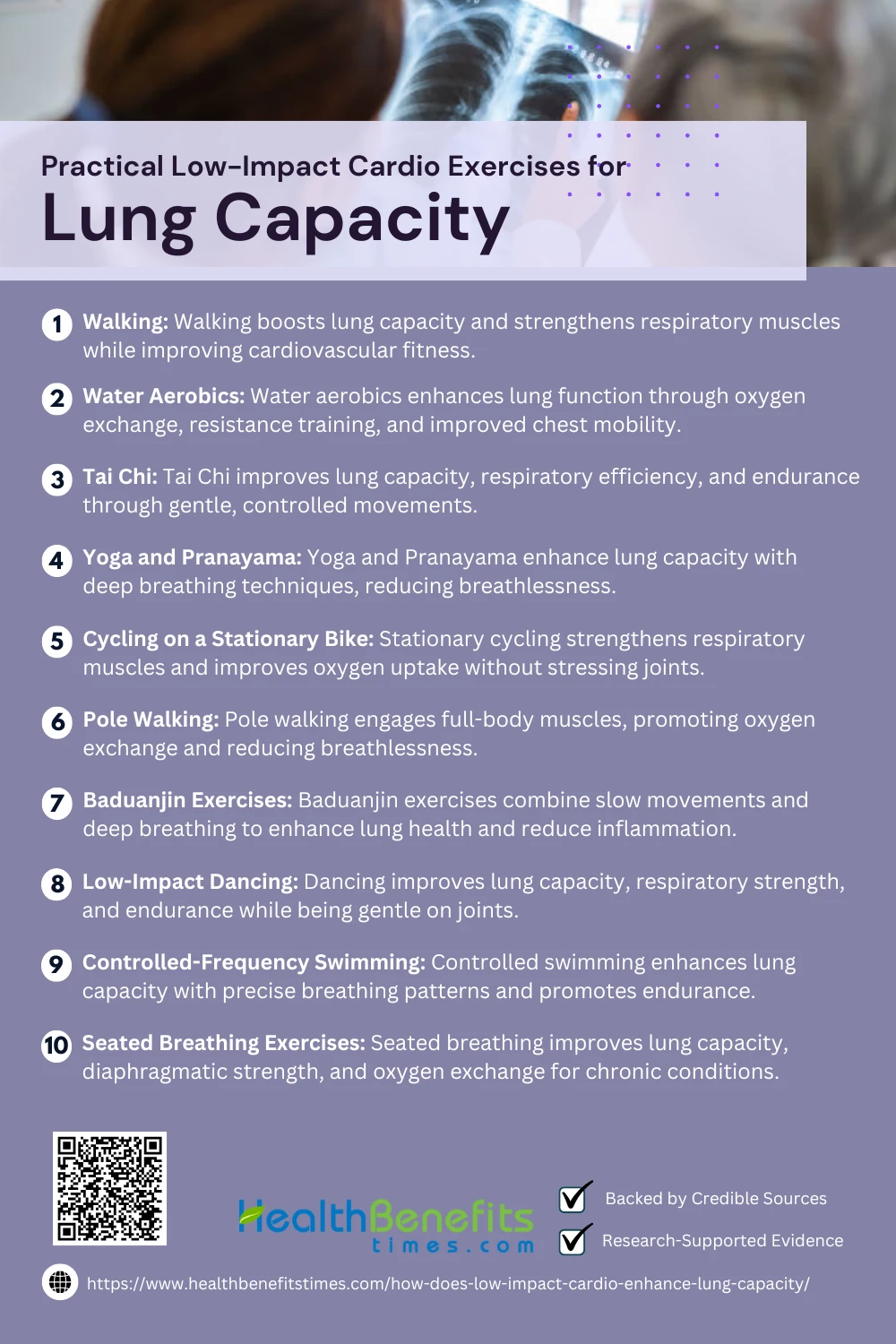 1. Walking
1. Walking
Walking is a low-impact cardio exercise that enhances lung capacity by improving oxygen exchange and strengthening respiratory muscles. It is particularly effective in boosting cardiovascular fitness and pulmonary efficiency without strain (39). Walking regularly increases endurance and reduces breathlessness in individuals with respiratory issues (41). Studies also highlight its ability to improve aerobic capacity and reduce lung inflammation (42).
2. Water Aerobics
Water aerobics enhances lung capacity by promoting better oxygen exchange and improving chest mobility. This low-impact exercise reduces strain on joints while increasing pulmonary function, making it suitable for individuals with respiratory conditions (41). Additionally, water-based routines enhance respiratory endurance through resistance offered by water (39). Studies highlight its role in reducing lung inflammation and improving alveolar health (43).
3. Tai Chi
Tai Chi enhances lung capacity through gentle, controlled movements that improve respiratory efficiency and oxygen exchange. This low-impact exercise strengthens diaphragmatic breathing, promotes alveolar health, and boosts endurance in chronic respiratory conditions (44). Tai Chi reduces fatigue and enhances cardiovascular performance (45). Its role in pulmonary rehabilitation is significant, particularly in COPD (46).
4. Yoga and Pranayama
Yoga and Pranayama enhance lung capacity by promoting diaphragmatic breathing and increasing oxygen exchange efficiency. Pranayama practices improve vital capacity and reduce breathlessness, particularly in individuals with respiratory conditions (32). Studies show Hatha Yoga strengthens respiratory muscles and boosts pulmonary function (47). Regular yoga practices have shown measurable improvements in lung elasticity and endurance (48).
5. Cycling on a Stationary Bike
Cycling on a stationary bike is a low-impact cardio exercise that enhances lung capacity by improving oxygen uptake and respiratory efficiency. It strengthens respiratory muscles and promotes cardiovascular fitness, aiding pulmonary rehabilitation (39). Studies show its effectiveness in improving lung function and reducing dyspnea in COPD patients (41). Cycling also reduces the impact on joints, making it suitable for individuals with mobility issues (49).
6. Pole Walking
Pole walking, or Nordic walking, is a practical low-impact exercise that enhances lung capacity by engaging both upper and lower body muscles, improving oxygen exchange and cardiovascular fitness. It is particularly beneficial for respiratory conditions, as it promotes diaphragmatic breathing and reduces breathlessness (50). Nordic walking also boosts physical function and quality of life in chronic respiratory diseases (51).
7. Baduanjin Exercises
Baduanjin exercises, a traditional Chinese practice combining slow movements and deep breathing, enhance lung capacity and promote oxygen exchange efficiency. This low-impact exercise also strengthens alveolar health, reducing inflammation (52). Regular practice boosts respiratory resilience and overall physical function (53).
8. Low-Impact Dancing
Low-impact dancing enhances lung capacity by promoting rhythmic breathing and improving oxygen exchange. It strengthens respiratory muscles while being gentle on joints, making it ideal for individuals with limited mobility (39). Studies show it boosts cardiovascular fitness and pulmonary function (54). Aerobic dance improves endurance and alleviates symptoms of respiratory conditions (55).
9. Controlled-Frequency Swimming
Controlled-frequency swimming enhances lung capacity by integrating precise breathing patterns, improving respiratory muscle strength, and optimizing oxygen exchange. Studies show its efficacy in reducing breathlessness and promoting endurance (56). This low-impact exercise benefits individuals with pulmonary limitations while enhancing cardiovascular efficiency (57).
10. Seated Breathing Exercises
Seated breathing exercises are effective for enhancing lung capacity and respiratory strength through controlled, low-impact movements. These exercises improve diaphragmatic efficiency and oxygen exchange, particularly for individuals with chronic conditions (41). They also alleviate respiratory distress and strengthen pulmonary function (58). Regular practice reduces dyspnea and improves endurance (32).
Benefits of Enhanced Lung Capacity
Enhanced lung capacity improves oxygen intake, boosts endurance, reduces fatigue, supports overall health, lowers respiratory disease risks, and enhances quality of life for daily activities and exercise.
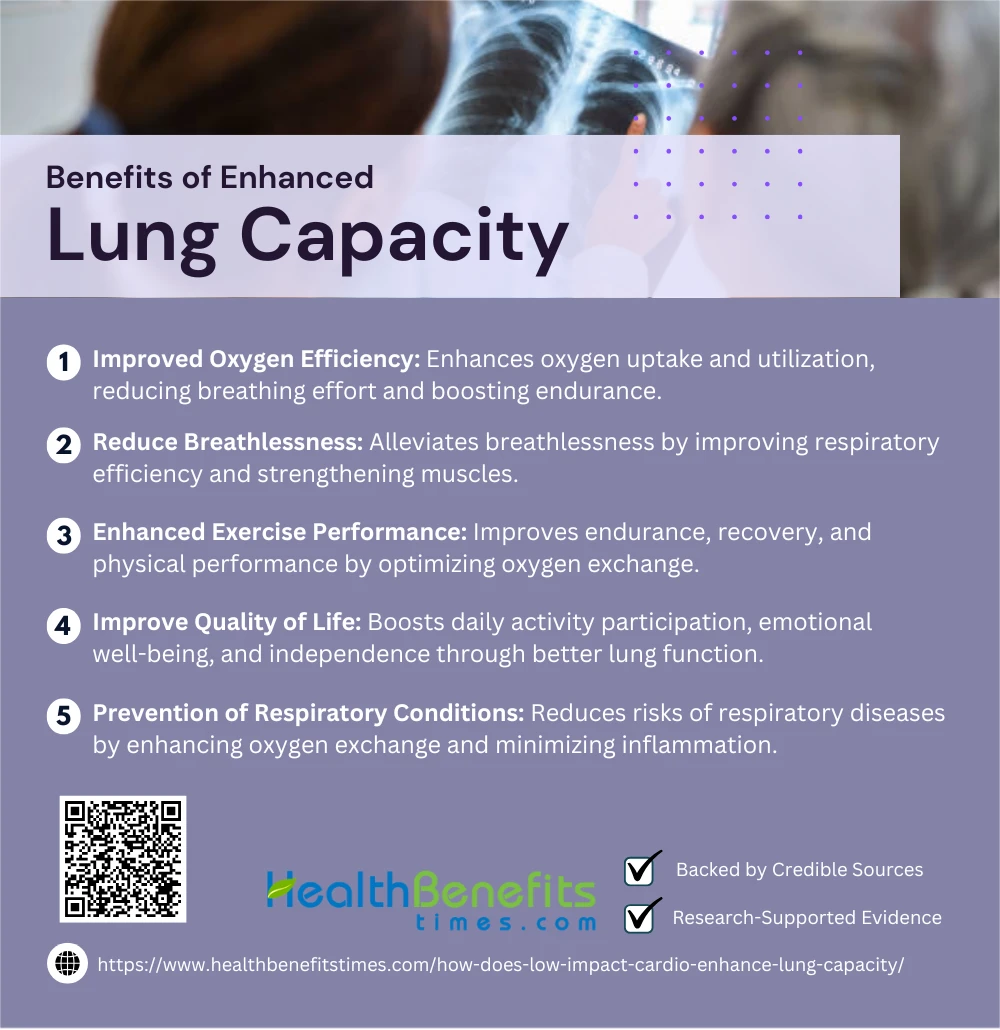 1. Improved Oxygen Efficiency
1. Improved Oxygen Efficiency
Enhanced lung capacity improves oxygen efficiency by enabling better oxygen uptake and utilization, critical for overall physical endurance (59). It reduces energy expenditure during breathing, benefiting individuals with respiratory conditions (60). Improved pulmonary function optimizes cardiovascular performance, reducing strain on the heart (61). Enhanced oxygen saturation levels contribute to better endurance in physical activities (62).
2. Reduce Breathlessness
Enhanced lung capacity significantly reduces breathlessness by improving oxygen efficiency and decreasing respiratory effort. It strengthens respiratory muscles, helping alleviate symptoms in conditions like asthma and COPD (63). Studies also highlight its role in post-COVID rehabilitation, reducing dyspnea and fatigue (64).
3. Enhanced Exercise Performance
Enhanced lung capacity directly contributes to improved exercise performance by optimizing oxygen exchange and reducing respiratory effort. It allows athletes to sustain high-intensity activities with less fatigue (65). Enhanced pulmonary function improves endurance and recovery rates (66). This physiological improvement also benefits recreational fitness, boosting cardiovascular efficiency (67).
4. Improve Quality of Life
Enhanced lung capacity improves quality of life by increasing oxygen efficiency and reducing fatigue, enabling better participation in daily activities (68). It alleviates symptoms of chronic respiratory conditions, promoting physical independence (69). Improved pulmonary function also boosts emotional well-being and social engagement (70).
5. Prevention of Respiratory Conditions
Enhanced lung capacity helps prevent respiratory conditions by improving oxygen exchange and reducing airway inflammation, a key factor in maintaining healthy lungs (71). It supports pulmonary resilience against chronic conditions such as asthma (72). Improved lung function reduces susceptibility to infections and respiratory illnesses (73).
Additional Tips for Maximizing Lung Capacity
- Practice Deep Breathing Techniques
Deep breathing exercises such as diaphragmatic breathing (breathing from the belly) and pursed-lip breathing are effective in improving oxygen exchange. These techniques strengthen the diaphragm, reduce residual air in the lungs, and help in conditions like COPD. Practicing for 10-15 minutes daily can enhance lung efficiency, particularly under stress or during physical exertion. Research shows diaphragmatic breathing improves pulmonary function significantly in chronic respiratory conditions. - Maintain Good Posture
Slouching or poor posture compresses the lungs, limiting their ability to expand. Sitting or standing upright opens the chest cavity, enabling better lung expansion and airflow. Specific posture-improving exercises, such as stretching or yoga, help maintain spinal alignment and increase breathing capacity. Studies reveal that maintaining good posture positively impacts lung volume. - Incorporate Cardiovascular Activities
Aerobic exercises like walking, swimming, or cycling are low-impact ways to strengthen respiratory muscles and improve pulmonary efficiency. These activities enhance oxygen uptake, increase blood circulation, and improve endurance by making the lungs work more efficiently over time. Consistent activity helps in conditions like asthma and pulmonary fibrosis. Cardiovascular exercises significantly improve aerobic capacity and lung function. - Stay Hydrated
Hydration helps maintain optimal lung function by thinning mucus in the airways, making it easier to expel through coughing. Drinking enough water (at least 8 glasses daily) prevents the buildup of thick mucus, which can obstruct airflow. Warm fluids, such as herbal teas, can further help in soothing irritated airways. Research highlights the importance of hydration for improving lung clearance and reducing respiratory effort. - Avoid Air Pollutants
Exposure to pollutants like cigarette smoke, industrial fumes, or airborne allergens can damage lung tissue and exacerbate respiratory conditions. Using masks in polluted environments, minimizing time spent outdoors during high smog levels, and avoiding secondhand smoke can protect the lungs. Minimizing air pollution exposure is linked to better respiratory outcomes. - Use Incentive Spirometers
Incentive spirometers are devices that help individuals practice slow, deep breathing to increase lung volume. Often used in post-surgery recovery or chronic respiratory illness, these devices prevent lung collapse and strengthen breathing muscles by encouraging deep inhalation. Regular use improves respiratory function significantly. Spirometers are effective tools for enhancing pulmonary performance. - Quit Smoking
Smoking damages lung tissue, reduces elasticity, and exacerbates chronic respiratory conditions. Quitting smoking improves lung function and reduces inflammation, lowering the risk of conditions such as emphysema, bronchitis, and lung cancer. Support tools like nicotine patches, counseling, or support groups can aid cessation efforts.
Studies confirm that smoking cessation leads to measurable improvements in respiratory health. - Optimize Indoor Air Quality
Using air purifiers, maintaining proper ventilation, and minimizing indoor allergens (such as dust, pet dander, or mold) significantly reduce the strain on lungs. Plants like areca palms and snake plants can also improve air quality naturally. Clean indoor environments correlate with improved respiratory outcomes.
Potential Limitations and Precautions
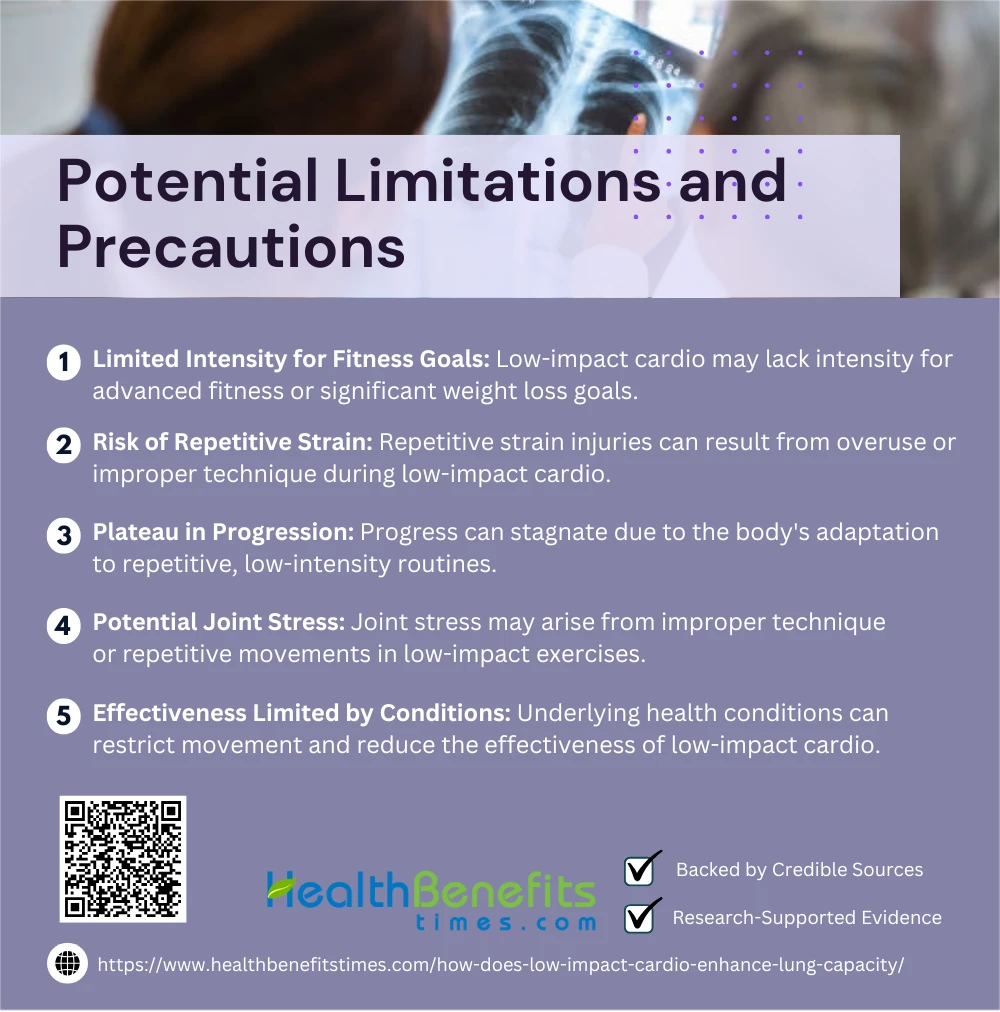 1. Limited Intensity for Fitness Goals
1. Limited Intensity for Fitness Goals
Low-impact cardio exercises, while beneficial for general fitness, may not provide sufficient intensity to achieve advanced cardiovascular goals or significant weight loss. This limitation can slow progress for those aiming to build endurance or strength (74). They also lack the progressive overload required for higher fitness thresholds (75).
2. Risk of Repetitive Strain
Repetitive strain injuries (RSIs) can occur during low-impact cardio exercises due to overuse of certain muscle groups or joints. Improper technique and lack of rest exacerbate the risk, potentially leading to inflammation or chronic pain (76). Employing proper form, adequate warm-ups, and varied routines minimizes these risks (77).
3. Plateau in Progression
A plateau in progression during low-impact cardio occurs when the body adapts to repetitive, low-intensity routines, hindering further fitness improvements. This limits muscle engagement and cardiovascular gains unless additional variations or intensities are incorporated (78). Periodic adjustments, resistance incorporation, and cross-training are recommended to overcome this stagnation.
4. Potential Joint Stress
Joint stress in low-impact cardio exercises can result from improper technique or overuse, particularly in repetitive activities like cycling or elliptical training. This may lead to inflammation or chronic pain if unaddressed (79). Using supportive footwear, maintaining proper posture, and varying routines can mitigate these risks (80).
5. Effectiveness Limited by Underlying Conditions
Effectiveness of low-impact cardio may be limited for individuals with underlying conditions like severe arthritis or advanced cardiovascular disease. These conditions can restrict movement or endurance, reducing exercise benefits (81). Precautions include tailored regimens under professional guidance to ensure safety and efficacy (82).
Conclusion
Low-impact cardio exercises, such as walking, swimming, and cycling, play a vital role in enhancing lung capacity by improving respiratory muscle strength, increasing oxygen exchange efficiency, and promoting overall cardiovascular health. These exercises are accessible and suitable for individuals of all fitness levels, making them an excellent way to improve breathing, endurance, and quality of life. Consistent practice not only supports lung function but also reduces the risk of respiratory diseases, providing long-term health benefits. By incorporating low-impact cardio into daily routines, individuals can enjoy improved respiratory health and a more active, vibrant lifestyle.
References:
- The Power of Aerobic Exercises.
- Effectiveness of Water Aerobics.
- Effect of Yogic Intervention.
- Comparison of Tai Chi and Wai Tan Kung.
- Effects of Low Impact Aerobic Exercise in COPD.
- Physiological Effects of Aerobic Exercise.
- Pilates and Lung Function.
- American Journal of Respiratory and Critical Care Medicine – Understanding Lung Function and Capacity
- NCBI – Gender and Age Differences in Lung Capacity
- CDC – Effects of Smoking on Lung Health
- WHO – Air Pollution and Lung Function
- ScienceDirect – Physical Activity and Lung Capacity
- PubMed – Obesity and Lung Function
- Mayo Clinic – Symptoms of Poor Lung Health
- Lung Association – Respiratory Infections and Lung Health
- NIH National Heart, Lung, and Blood Institute – Understanding COPD and Asthma
- Senthil, P., & others (2022). Effectiveness of water aerobics in improving chest mobility and pulmonary function. ResearchGate.
- Kashyap, N. (2023). Neurorehabilitation Techniques. ResearchGate.
- Csepregi, É. (2024). Effects of Breathing Exercises on Pulmonary Function. UniDeb.
- DeTurk, W.E., & Johnson, L. (2004). Cardiovascular and Pulmonary Physical Therapy: An Evidence-Based Approach. DoctorLib.
- Zhu, Z., Pan, X., & Ong, M.L.Y. (2023). Baduanjin Rehabilitation for Lung Function. Wiley Online Library.
- Obeagu, E.I., & Obeagu, G.U. (2024). Maternal Hypoxia: Impact on Cardiovascular Health and Placental Function. Academia.
- Ashwini, K. (2020). Physical Activity and Immune System. ResearchGate.
- Tramontano, A., & Palange, P. (2023). Nutritional State and COPD: Effects on Dyspnoea and Exercise Tolerance. MDPI.
- Armstrong, M., & Vogiatzis, I. (2019). Personalized Exercise Training in Chronic Lung Diseases. Wiley Online Library.
- Dreher, M., & Kabitz, H.J. (2012). Impact of Obesity on Exercise Performance and Pulmonary Rehabilitation. Wiley Online Library.
- Sankar, U.G., & Doss, C.A.V. (2020). Effects of Low Impact Aerobic Exercise in COPD. Biomed Pharma Journal.
- Bradford, C., Martin, D., & Loughran, K.J. (2023). The Impact of Sport on the Physical, Psychological, and Social Wellbeing of People with Chronic Breathlessness. SAGE Journals.
- Liu, W., Huang, Y.L., Zhang, X.W., & Yu, P.M. (2023). Tai chi as a complementary exercise for pulmonary rehabilitation in COPD. ScienceDirect.
- Spruit, M.A., Singh, S.J., & Garvey, C. (2013). Key Concepts and Advances in Pulmonary Rehabilitation. ATS Journals.
- Naqvi, W.M., & Sahu, A. (2020). Quarantine Exercises in the Time of Covid-19. Academia.
- Singh, B.R., & Singh, M.K. (2024). Yoga for Healthy Lungs – Unlocking the Power of Pranayama. CATKP.
- Cordova-Rivera, L., Gardiner, P.A., & Gibson, P.G. (2018). Physical Activity and Exercise Capacity in Severe Asthma. Newcastle University.
- Nici, L., Donner, C., & Zuwallack, R. (2006). Key Concepts and Advances in Pulmonary Rehabilitation. ATS Journals.
- Maltais, F., Decramer, M., & Casaburi, R. (2014). Update on Limb Muscle Dysfunction in COPD. ATS Journals.
- Jiwtoode, M.T., & Mahajan, M. (2016). Effect of Duration of Yoga Training on Pulmonary Function. Al Ameen Medical.
- Bhagel, P., Pathak, A., & Chosphel, T. (2022). Effect of Yogic Intervention on Pulmonary Function. International Journal of Sports Science.
- Promsrisuk, T., Kongsui, R., & Sriraksa, N. (2023). Elastic Band Resistance Combined with Yoga for Pulmonary Benefits. NCBI.
- Kashyap, N. (2023). Neurorehabilitation Techniques. ResearchGate.
- Cavero-Redondo, I. (2024). Effect of Controlled Aerobic Exercises on Lung Function. ScienceDirect.
- Senthil, P., Muralidharan, C.K., & Swathi, S. (2022). Effectiveness of water aerobics in improving chest mobility and pulmonary function in chronic stroke patients. ResearchGate.
- Zainuldin, R., Mackey, M.G., & Alison, J.A. (2015). Prescription of walking exercise intensity from the 6-minute walk test. Journal of Cardiopulmonary Rehabilitation.
- Scheer, A., Shah, A., & Oliveira, B.I.R. (2021). Twelve weeks of water-based circuit training exercise improves fitness. ScienceDirect.
- Zhang, L.L., Wang, S.Z., Chen, H.L., & Yuan, A.Z. (2016). Tai Chi exercise for cancer-related fatigue in lung cancer patients. ScienceDirect.
- Mahalakshmi, A.L., & Shaji, J.C.H. (2024). Tai Chi and its Impact on Health. LWW Journals.
- Wayne, P.M., Litrownik, D., & Beach, D. (2020). BEAM study: Tai Chi for COPD. BMJ Open Respiratory.
- Clay, C.C., Lloyd, L.K., & Walker, J.L. (2005). The Metabolic Cost of Hatha Yoga. LWW Journals.
- Mishra, S.K., Singh, P., & Bunch, S.J. (2012). Therapeutic Value of Yoga in Neurological Disorders. LWW Journals.
- Ditroilo, M., Lucertini, F., & De Vito, G. (2009). The Cardiovascular Response to Underwater Pedaling. Academia.
- Prevost, S. (2016). CYCLE: An Innovative Research Program of Early In-bed Cycling with Mechanically Ventilated Patients. ICU Cycle.
- Cunningham, E., Weaver, R.R., & Lemonde, M. (2020). Nordic Pole Walking for Individuals with Cancer. LWW Journals.
- Cheng, Y.T., & Chao, S.F. (2022). Movement-based mind-body interventions for cardiac rehabilitation: An updated systematic review. Tzu Chi Medical Journal.
- McGee, R.W. (2021). Tai Chi, Qigong and the Treatment of Arthritis. Biomedical Journal of Scientific & Technical Research.
- Bjelica, B. (2023). Efficiency of Group Fitness Programs on Women’s Health Fitness. ResearchGate.
- Kumar, K., & David, D.J. (2019). Combined Effect of Aerobic Dance and Resistance Training on Cardio Respiratory Fitness. Journal of Sports.
- Lavin, K.M., Guenette, J.A., & Smoliga, J.M. (2015). Controlled-Frequency Breath Swimming Improves Performance and Running Economy. Scandinavian Journal of Medicine & Science in Sports.
- Guenette, J.A., & Smoliga, J.M. (2015). Impact of Controlled-Frequency Swimming on Pulmonary Efficiency. Wiley Online Library.
- Iolascon, G., & others (2018). The Role of Rehabilitation in Respiratory Management. NCBI.
- Lee, D.J. (2024). On the Respiratory Consequences of Air-to-Water Transition. Open Library.
- Donadello, E. (2024). Design and Efficacy of Redox Cyclers for Mitochondrial Diseases. Thesis Repository.
- Wilson, S., et al. (2024). Early Rehabilitation Benefits in Heart Failure Patients. Critical Care Medicine.
- Lin, Y., et al. (2024). Therapies for Sleep-Disordered Breathing in Heart Failure. ScienceDirect.
- Swain, S., Sharma, N., & Negi, S. (2024). A Prospective Study on Quality of Life in Children with Asthma and their Care Givers. Research Journal of Medical Sciences.
- Mooren, J.M., et al. (2024). Post-COVID-19 Pulmonary Rehabilitation Outcomes. BMC Medicine.
- Khedr, S.S.K. (2024). Benefits of Enhanced Lung Capacity in Physical Performance. EKB Journals.
- Thomas, R. (2024). Effect of Enhanced Lung Function on Recovery in Exercise. IAJESM.
- Piepiora, P.A., Piepiora, Z.N., & Stackeová, D. (2024). Physical Culture for Mental and Physical Health. Frontiers in Psychology.
- Mirza, F.T., Uzzaman, M.N., & Salazar, J.J. (2025). Pulmonary Rehabilitation Programs and Their Effects on Quality of Life. ScienceDirect.
- Izquierdo, M., Souto Barreto, P., & Arai, H. (2025). Exercise Recommendations for Longevity in Older Adults. ScienceDirect.
- Mosher, C.L. (2025). Telerehabilitation in Chronic Respiratory Disease. ATS Journals.
- Dias, E., & Poojary, D.D. (2024). Senolytics and Dietary Phytochemicals. ResearchGate.
- Shah, S.R., & Singh, V. (2024). Impact of Yoga on Circulation and Lung Health. JYESSPE.
- Fusco, J., & Venkataraman, V. (2024). Cardiovascular and Respiratory Benefits from Sauna Bathing. Cureus.
- Pillay, L., Mkumbuzi, N.S., & Douryang, M. (2024). WHO Rehabilitation 2030: Fitness Perspectives. Frontiers in Rehabilitation Sciences.
- Sempere-Ruiz, N., Fuertes-Kenneally, L., & Rogers, T. (2024). Heart Rate Variability in Chronic Conditions. European Journal of Preventive Cardiology.
- Azierski, M., Talarek, K., & Pikor, D. (2024). Modern Diagnostic Methods for Fatigue Fractures. ResearchGate.
- Navajas, S. (2024). Cannabis-Induced Inflammation and Cardiovascular Risks. ScienceDirect.
- Li, Y. (2024). Filtrate rDON and Ortho-P Control Through Coagulant Addition. AccessWater.
- Mohamed, H., Hassanli, R., Zhuge, Y., Ma, X., & Bazli, M. (2024). Beam-column connections in GFRP-RC moment resisting frames. ResearchGate.
- El-Naqeeb, M.H., & Hassanli, R. (2024). Structural Implications in Cardiovascular Stress Management. ScienceDirect.
- Stelmashchuk, D. (2024). Diagnosis and Treatment of Meralgia Paresthetica. GenesisPub.
- He, L., Edi, S., & Ma, J. (2024). Prevention and Treatment of Radiation Injury. ScienceDirect.

